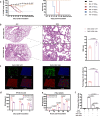Dual receptor-binding, infectivity, and transmissibility of an emerging H2N2 low pathogenicity avian influenza virus
- PMID: 39562538
- PMCID: PMC11576999
- DOI: 10.1038/s41467-024-54374-z
Dual receptor-binding, infectivity, and transmissibility of an emerging H2N2 low pathogenicity avian influenza virus
Abstract
The 1957 H2N2 influenza pandemic virus [A(H2N2)pdm1957] has disappeared from humans since 1968, while H2N2 avian influenza viruses (AIVs) are still circulating in birds. It is necessary to reveal the recurrence risk and potential cross-species infection of these AIVs from avian to mammals. We find that H2 AIVs circulating in domestic poultry in China have genetic and antigenic differences compared to the A(H2N2)pdm1957. One H2N2 AIV has a dual receptor-binding property similar to that of the A(H2N2)pdm1957. Molecular and structural studies reveal that the N144S, and N144E or R137M substitutions in hemagglutinin (HA) enable H2N2 avian or human viruses to bind or preferentially bind human-type receptor. The H2N2 AIV rapidly adapts to mice (female) and acquires mammalian-adapted mutations that facilitated transmission in guinea pigs and ferrets (female). These findings on the receptor-binding, infectivity, transmission, and mammalian-adaptation characteristics of H2N2 AIVs provide a reference for early-warning and prevention for this subtype.
© 2024. The Author(s).
Conflict of interest statement
Figures







References
-
- Shortridge, K. F. et al. Interspecies transmission of influenza viruses: H5N1 virus and a Hong Kong SAR perspective. Vet. Microbiol.74, 141–147 (2000). - PubMed
-
- Chen, H. et al. Clinical and epidemiological characteristics of a fatal case of avian influenza A H10N8 virus infection: a descriptive study. Lancet383, 714–721 (2014). - PubMed
Publication types
MeSH terms
Substances
Associated data
- Actions
- Actions
- Actions
Grants and funding
LinkOut - more resources
Full Text Sources
Medical

